Naqada is a town on the west bank of the Nile River in Egypt.
Naqada may also refer to:

Buto, Bouto, Butus or Butosus was a city that the Ancient Egyptians called Per-Wadjet. It was located 95 km east of Alexandria in the Nile Delta of Egypt. What in classical times the Greeks called Buto, stood about midway between the Taly (Bolbitine) and Thermuthiac (Sebennytic) branches of the Nile, a few kilometers north of the east-west Butic River and on the southern shore of the Butic Lake.
Upper Egypt is the southern portion of Egypt and is composed of the Nile River valley south of the delta and the 30th parallel N. It thus consists of the entire Nile River valley from Cairo south to Lake Nasser.
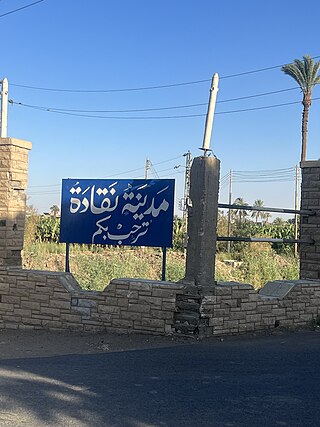
Naqada, is a town on the west bank of the Nile in Qena Governorate, Egypt, situated ca. 20 km north of Luxor. It includes the villages of Tukh, Khatara, Danfiq, and Zawayda. According to 1960 census, it is one of the most uninhabited areas and had only 3,000 inhabitants, mostly of Christian faith who preserved elements of the Coptic language up until the 1930s.

Nekhen, also known as Hierakonpolis was the religious and political capital of Upper Egypt at the end of prehistoric Egypt and probably also during the Early Dynastic Period.
The Early Dynastic Period, also known as Archaic Period or the Thinite Period, is the era of ancient Egypt that immediately follows the unification of Upper and Lower Egypt in c. 3150 BC. It is generally taken to include the First Dynasty and the Second Dynasty, lasting from the end of the archaeological culture of Naqada III until c. 2686 BC, or the beginning of the Old Kingdom. With the First Dynasty, the Egyptian capital moved from Thinis to Memphis, with the unified land being ruled by an Egyptian god-king. In the south, Abydos remained the major centre of ancient Egyptian religion; the hallmarks of ancient Egyptian civilization, such as Egyptian art, Egyptian architecture, and many aspects of Egyptian religion, took shape during the Early Dynastic Period.

Prehistoric Egypt and Predynastic Egypt span the period from the earliest human settlement to the beginning of the Early Dynastic Period around 3100 BC, starting with the first Pharaoh, Narmer for some Egyptologists, Hor-Aha for others, with the name Menes also possibly used for one of these kings.
The Badarian culture provides the earliest direct evidence of agriculture in Upper Egypt during the Predynastic Era. It flourished between 4400 and 4000 BC, and might have already emerged by 5000 BC.

Hedjet is the White Crown of pharaonic Upper Egypt. After the unification of Upper and Lower Egypt, it was combined with the Deshret, the Red Crown of Lower Egypt, to form the Pschent, the double crown of Egypt. The symbol sometimes used for the White Crown was the vulture goddess Nekhbet shown next to the head of the cobra goddess Wadjet, the uraeus on the Pschent.
The Gerzeh culture, also called Naqada II, refers to the archaeological stage at Gerzeh, a prehistoric Egyptian cemetery located along the west bank of the Nile. The necropolis is named after el-Girzeh, the nearby contemporary town in Egypt. Gerzeh is situated only several miles due east of the oasis of Faiyum.
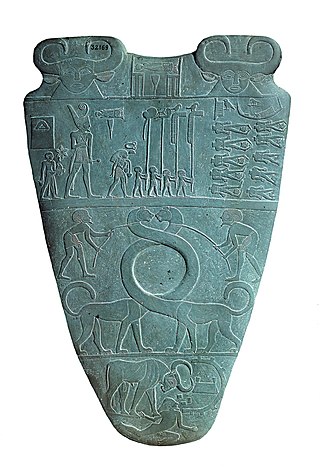
Naqada III is the last phase of the Naqada culture of ancient Egyptian prehistory, dating from approximately 3200 to 3000 BC. It is the period during which the process of state formation, which began in Naqada II, became highly visible, with named kings heading powerful polities. Naqada III is often referred to as Dynasty 0 or the Protodynastic Period to reflect the presence of kings at the head of influential states, although, in fact, the kings involved would not have been a part of a dynasty. In this period, those kings' names were inscribed in the form of serekhs on a variety of surfaces including pottery and tombs.
Scorpion I was a ruler of Upper Egypt during Naqada III. He was one of the first rulers of Ancient Egypt, and a graffito of him depicts a battle with an unidentified predynastic ruler. His tomb is known for the evidence of early examples of wine consumption in Ancient Egypt.
The dynastic race theory was the earliest thesis to attempt to explain how predynastic Egypt developed into the sophisticated monarchy of Dynastic Egypt. The theory holds that the earliest roots of the ancient Egyptian dynastic civilisation were imported by invaders from Mesopotamia who then founded the First Dynasty and brought culture to the indigenous population. This theory had strong supporters in the Egyptological community in the first half of the 20th century, but has since lost mainstream support.
The A-Group culture was an ancient culture that flourished between the First and Second Cataracts of the Nile in Lower Nubia. It lasted from c. 3800 BC to c. 3100 BC.
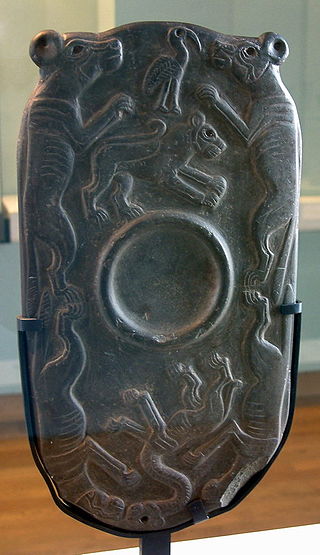
Cosmetic palettes are archaeological artifacts, originally used in predynastic Egypt to grind and apply ingredients for facial or body cosmetics. The decorative palettes of the late 4th millennium BCE appear to have lost this function and became commemorative, ornamental, and possibly ceremonial. They were made almost exclusively out of siltstone with a few exceptions. The siltstone originated from quarries in the Wadi Hammamat.
The Amratian culture, also called Naqada I, was an archaeological culture of prehistoric Upper Egypt. It lasted approximately from 4000 to 3500 BC.
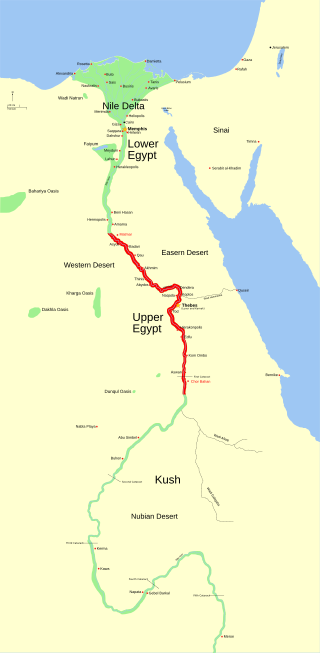
The Naqada culture is an archaeological culture of Chalcolithic Predynastic Egypt, named for the town of Naqada, Qena Governorate. A 2013 Oxford University radiocarbon dating study of the Predynastic period suggests a beginning date sometime between 3,800 and 3,700 BC.

The following outline is provided as an overview of a topical guide to ancient Egypt:

Abu Tesht or Abu Tisht is a city and markaz in Qena Governorate, Egypt. It is situated on the west bank of the Nile.
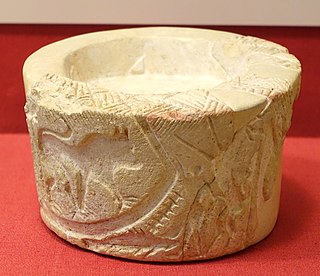
Qustul is an archaeological cemetery located on the eastern bank of the Nile in Lower Nubia, just opposite of Ballana near the Sudan frontier. The site has archaeological records from the A-Group culture, the New Kingdom of Egypt and the X-Group culture.

Egypt–Mesopotamia relations were the relations between the civilisations of ancient Egypt and Mesopotamia, in the Middle East. They seem to have developed from the 4th millennium BCE, starting in the Uruk period for Mesopotamia and the half a millennium younger Gerzean culture of Prehistoric Egypt, and constituted a largely one way body of influences from Mesopotamia into Egypt.